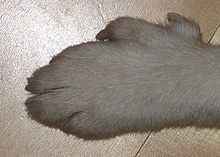| Country of origin | Norway |
|---|
Appearance
The Norwegian Lundehund is a small, rectangular Spitz type dog. The Lundehund has a great range of motion in its joints, allowing it to fit into and extricate itself from narrow passages. Dogs of this breed are able to bend their head backwards along their own spine and turn their forelegs to the side at a 90-degree horizontal angle to their body, much like human arms. Their pricked, upright ears can be folded shut to form a near-tight seal by folding forward or backward. The Norwegian Lundehund is a polydactyl: instead of the normal four toes per foot, the Lundehund normally has six toes, all fully formed, jointed and muscled. Some specimens may have more, or fewer, than six toes per foot; although having fewer than six toes is frowned upon and will lose the dog points in a show ring.[note 1] The outercoat is dense and rough with a soft undercoat. The Lundehund is adapted to climb narrow cliff paths in Røst where it originally would have hunted puffins.
History
The breed has a long history. As far back as 1600 it was used for hunting puffins along the Norwegian coast. Its flexibility and extra toes were ideal for hunting the birds in their inaccessible nesting locations on cliffs and in caves. Interest for the breed declined when new methods for hunting puffins were invented and a dog tax was created. Around 1900, they were only found in the isolated village of Mostad (spelled Måstad in Norwegian), Lofoten. The breed was nearly extinct around World War II when canine distemper struck Værøy and the surrounding islands. In 1963, the population was further decimated by distemper again. This time, only 6 dogs survived (1 on Værøy & 5 in southern Norway Hamar (these 5 were from the same mother)), creating a population bottleneck. Due to careful breeding with strict guidelines, there are now an estimated 1500–2000 dogs in the world, with around 1100 of the population in Norway and ~350 in the United States. Height:13–15 inches Weight: 13–15 pounds.
Lundehund Gastroenteropathy
Lundehund gastroenteropathy is a set of digestive disorders that can lead to an overgrowth of digestive bacteria, and a loss of ability to absorb nutrients from food.[1] In extreme cases the dog can starve due to its inability to derive nutrients and protein from food, regardless of food intake. All Lundehunds have the genetics to have this illness, though not every Lundehund is severely afflicted and some are symptom free. There is no cure, though the disease can be managed.
American Kennel Club
The Norwegian Lundehund, listed in the Foundation Stock Service was approved to move to the Miscellaneous Class of the American Kennel Club on November 13, 2007, by a unanimous vote of the AKC Board of Directors, effective date to be July 1, 2008. After an evaluation period in the Miscellaneous Class (reviewed in 6-month increments, effective in January & July), the breed is slated to progress into the Non-Sporting Group. The Lundehund made its AKC conformation debut at the Roaring Fork Kennel Club show in Eagle, Colorado on July 12, 2008.
The Lundehund made its introductory premier at a major US event at the 2008 AKC/Eukanuba National Championship show in Long Beach, California on December 13 and 14, 2008. Four Lundehunds were present for introductions and inspections by judges and the public at a meet-the-breed booth, constituting one of the 153 breeds represented. From this event, the Norwegian Lundehund Association of America has been asked to instruct at several upcoming judges' education events – a major aspect of the AKC plan for full recognition of the breed. Since this event, the NLAA has presented Judge's Education Seminars at the Rose City Classic in Portland, Oregon and the Non-Sporting Judge's Institute in Houston, Texas.
Other aspects in the plan for full recognition include active participation in AKC events (conformation, agility, etc.) and expanding the general dog fancier's knowledge of the breed.
On February 12, 2010, the Board of Directors of the American Kennel Club voted to accept the Norwegian Lundehund "into the Stud Book of the AKC on December 1, 2010. The breed will be eligible to compete in the Non-Sporting Group beginning January 1, 2011."
Please note that as of 2011 the Norwegian Lundehund has received full AKC recognition.




No comments:
Post a Comment